Barbary macaque
The Barbary macaque (Macaca sylvanus), also known as Barbary ape or magot, is a macaque species native to the Atlas Mountains of Algeria and Morocco along with a small population of uncertain origin in Gibraltar.[1] It is one of the best-known Old World monkey species.[4]

| Barbary macaque | |
|---|---|
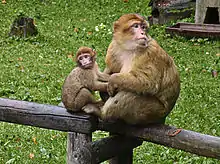 | |
| Young Barbary macaque with its mother | |
| Scientific classification | |
| Kingdom: | Animalia |
| Phylum: | Chordata |
| Class: | Mammalia |
| Order: | Primates |
| Suborder: | Haplorhini |
| Infraorder: | Simiiformes |
| Family: | Cercopithecidae |
| Genus: | Macaca |
| Species: | M. sylvanus[2] |
| Binomial name | |
| Macaca sylvanus[2] | |
 | |
| Barbary macaque range | |
| Synonyms | |
|
Simia sylvanus Linnaeus, 1758 | |
The Barbary macaque is of particular interest because males play an atypical role in rearing young. Because of uncertain paternity, males are integral to raising all infants. Generally, Barbary macaques of all ages and sexes contribute in alloparental care of young.[5]
The diet of Barbary macaque consists primarily of plants and insects and they are found in a variety of habitats. Males live to around 25 years old while females may live up to 30 years.[6][7] Besides humans, they are the only free-living primates in Europe. Although the species is commonly referred to as the "Barbary ape", the Barbary macaque is actually a true monkey. Its name refers to the Barbary Coast of Northwest Africa.
The Barbary macaque population of Gibraltar is the only such population outside Northern Africa and the only population of wild monkeys in Europe.
About 230 macaques live on the Rock of Gibraltar.[8] This population appears to be stable or increasing, while the North African population is declining.
Taxonomy
Simia sylvanus was the scientific name proposed by Carl Linnaeus in 1758 for a short-tailed macaque native to Africa.[3]
Phylogeny
Phylogenetic and molecular analyses show that the Barbary macaque is closely related to macaque species in Asia. Scientists have also studied the Y-chromosome, but this has proven unfruitful. One study indicates that the Barbary macaque has origins in Morocco and Algeria. The results of a phylogenetic analysis show that the chromosomes of Barbary macaque resemble those of the rhesus macaque with the exception of chromosomes 1, 4, 9, and 16.[7]
Physical description
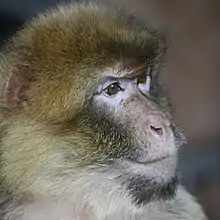

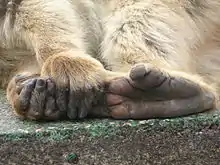
The monkey is yellowish-brown to grey with a lighter underside. The Barbary macaque has a mean body length of 556.8 mm (21.9 in) in females and 634.3 mm (25.0 in) in males, and mean body weight is reported to be 9.9 ± 10.3 kg (21.8 lbs) in females and 14.5 ± 17.5 kg (32.0 lbs) in males.[7] Its face is dark pink and its tail is vestigial, measuring anywhere from 4 to 22 mm (0.16 to 0.87 in).[7] Males often have a more prominent tail. The front limbs of this monkey are longer than its hind limbs. Females are smaller than males.[9]
Distribution and habitat
.jpg.webp)
The Barbary macaque lives mainly in the Atlas and Rif Mountain ranges of Morocco and Algeria. It is the only macaque species that is distributed outside Asia. It can live in a variety of habitats, such as cedar, fir, and oak forests, or grasslands, scrub, or rocky ridges full of vegetation. Most Barbary macaques inhabit cedar forests currently in the Atlas Mountains, but this could reflect the present habitat availability rather than a specific preference for this habitat.[7]
Behaviour and ecology
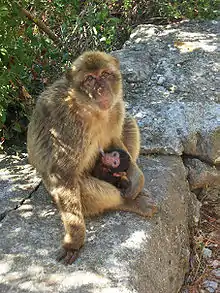
The Barbary macaque is gregarious, forming mixed groups of several females and males. Troops can have 10 to 100 individuals and are matriarchal, with their hierarchy determined by lineage to the lead female.[10] Unlike other macaques, the males participate in rearing the young.[10] Males may spend a considerable amount of time playing with and grooming infants. In this way, a strong social bond is formed between males and juveniles, both the male's own offspring and those of others in the troop. This may be a result of selectivity on the part of the females, who may prefer highly parental males.[5]
The mating season runs from November through March. The gestation period is 147 to 192 days, and females usually have only one offspring per pregnancy. Females rear twins in rare instances. Offspring reach maturity at three to four years of age, and may live for 20 years or more.[11]
Grooming other Barbary macaques leads to lower stress levels for the individuals that do the grooming.[12] While stress levels do not appear to be reduced in animals that are groomed, grooming more individuals leads to even lower stress levels; this is a benefit that might outweigh the costs to the groomer, which include less time to participate in other activities such as foraging. The mechanism for reducing stress may be explained by the social relationships (and support) that are formed by grooming.[12]
Male Barbary macaques interfere in conflicts and form coalitions with other males, usually with related males rather than with unrelated males. These relationships suggest that males do so in order to indirectly increase their own fitness. Furthermore, males form coalitions with closely related kin more often than they do with distantly related kin.[13] These coalitions are not permanent and may change frequently as male ranking within the group changes. Although males are more likely to form coalitions with males who have helped them in the past, this is not as important as relatedness in determining coalitions.[13] Males avoid conflicting with higher ranking males and will more frequently form coalitions with the higher ranking male in a conflict.[13] Close grouping of males occur when infant Barbary macaques are present. Interactions between males are commonly initiated when a male presents an infant macaque to an adult male who is not caring for an infant, or when an unattached male approaches males who are caring for infants. This behaviour leads to a type of social buffering, which reduces the number of antagonistic interactions among males in a group.[10]
An open mouth display by the Barbary macaque is used most commonly by juvenile macaques as a sign of playfulness.[14]
Alarm calls
The main purpose of calls in Barbary macaques is to alert other group members to possible dangers such as predators. Barbary macaques can discriminate calls by individuals in their own group from those by individuals in other groups of conspecific macaques.[15] Neither genetic variation nor habitat differences are likely causes of acoustic variation in the calls of different social groups. Instead, minor variations in acoustic structure among groups similar to the vocal accommodation seen in humans are the likely cause. However, acoustic characteristics such as pitch and loudness are varied based on the vocalizations of individuals they associate with, and social situations play a role in the acoustic structure of calls.[15]
Barbary macaque females have the ability to recognize their own offspring's calls through a variety of acoustic parameters.[16] Because of this, infant calls do not have to differ dramatically for mothers to be able to recognize their own infant's call. Mothers demonstrate different behaviours on hearing the calls of other infant macaques as opposed to the calls of their own offspring.[16] More parameters for vocalizations lead to more reliable identification of calls in both infants and in adult macaques so it is not surprising that the same acoustic characteristics that are heard in infant calls are also heard in adult calls.[16]
Mating

Although Barbary macaques are sexually active at all points during a female's reproductive cycle, male Barbary macaques determine a female's most fertile period by sexual swellings on the female.[17] Mating is most common during a female's most fertile period. The swelling size of the female reaches a maximum around the time of ovulation, suggesting that size helps a male predict when he should mate. This is further supported by the fact that male ejaculation peaks at the same time that female sexual swelling peaks. Change in female sexual behaviour around the time of ovulation is insufficient to demonstrate to the male that the female is fertile. The swellings, therefore, appear necessary for predicting fertility.[17]
Barbary macaque females differ from other nonhuman primates in that they often mate with a majority of the males in their social group. While females are active in choosing sexual associations, the mating behaviour of macaque social groups is not entirely determined by female choice.[18] These multiple matings by females decrease the certainty of paternity of male Barbary macaques, and may lead them to care for all infants within the group. For a male to ensure his reproductive success, he must maximize his time spent around the females in the group during their fertile periods. Injuries to male macaques peak during the fertile period, which points to male-male competition as an important determinant of male reproductive success.[18] Not allowing a female to mate with other males, however, would be costly to the male, since doing so would not allow him to mate with more females.[18]
Parenting
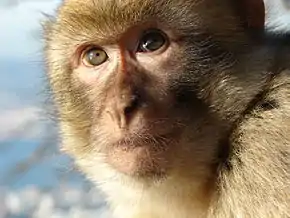
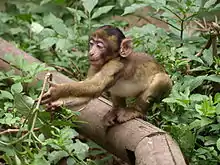
Unlike other macaques where most parental care comes from the mother, Barbary macaques from all age and sex groups participate in alloparental care of infants. Male care of infants has been of particular interest to research because high levels of care from males are uncommon in groups where paternity is highly uncertain. Males even act as true alloparents of infant macaques by carrying them and caring for them for hours at a time as opposed to just demonstrating more casual interactions with the infants. Female social status plays a role in female alloparental interactions with infants. Higher-ranking females have more interactions, whereas younger, lower-ranking females have less access to infants.[5]
Diet
The diet of the Barbary macaque consists of a mixture of plants and insect prey.[7] It consumes a large variety of gymnosperms and angiosperms. Almost every part of the plant is eaten, including flowers, fruits, seeds, seedlings, leaves, buds, bark, gum, stems, roots, bulbs, and corns.[7] Common prey caught and consumed by Barbary macaques are snails, earthworms, scorpions, spiders, centipedes, millipedes, grasshoppers, termites, water striders, scale insects, beetles, butterflies, moths, ants, and even tadpoles.[7]
Barbary macaques can cause major damage to the trees in their prime habitat, the Atlas cedar forests in Morocco. Since deforestation in Morocco has become a major environmental problem in recent years, research has been conducted to determine the cause of the bark stripping behaviour demonstrated by these macaques. Cedar trees are also vital to this population of Barbary macaques as an area with cedars can support a much higher density of macaques than one without them. A lack of a water source and exclusion of monkeys from water sources are major causes of cedar bark stripping behaviour in Barbary macaques. Density of macaques, however, is less correlated with the behaviour than the other causes considered.[19]
Predators
Their main predators are leopards, eagles (golden eagles may only predate on cubs, since they are not morphologically adapted to hunt primates; other birds of prey that do kill monkeys, like the crowned eagle, live in more southern areas of Africa),[20] and domestic dogs.[7] The approach of eagles and domestic dogs is known to elicit an alarm call response.[7]
Threats
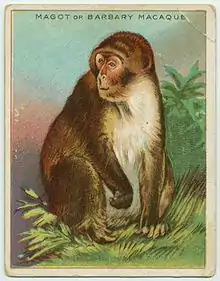
Wild populations of Barbary macaques have suffered a major decline in recent years to the point of being declared an endangered species on the IUCN Red List since 2008. The Barbary macaque is threatened by fragmentation and degradation of forest habitat and poaching for the illegal pet trade, and it is killed in retaliation for raiding crops.[1][21]
Spain is the main entry point in Europe. Today, no accurate data exist on the location and number of individuals out of their habitat. An unknown number of individuals is included in zoological collections, at other institutions, in private hands, in storage, or waiting to be relocated to appropriate destinations.[1]
The habitat of the Barbary macaque is under threat from increased logging activity.[22] Local farmers view the monkeys as pests, and engage in extermination of the species. Once common throughout northern Africa and southern Europe, only an estimated 12,000 to 21,000 Barbary macaques are left in Morocco and Algeria. Once, their distribution was much more extensive, reaching Tunisia and Libya. Their range is no longer continuous, with only isolated areas of range remaining. During the Pleistocene, this species inhabited the Mediterranean coasts and Europe, reaching Italy, Hungary, Spain, Portugal, and France, and as far north as Germany and the British Isles.[23] The species decreased with the arrival of the Ice Age, becoming extinct in the Iberian Peninsula 30,000 years ago.[24]
The Barbary macaque is threatened by habitat loss, overgrazing, and illegal capture. In Morocco, tourists interact with Barbary macaques in many regions. Information collected in the interviews with inhabitants in the High Atlas of Morocco indicated that the capture of macaques occurs in these regions. Conflict between local people and wild macaques is one of the greatest challenges to Barbary macaque conservation in Morocco. The main threats to the survival of Barbary macaques in this region have been found to be habitat destruction and the impact of livestock grazing, but problems of conflict with inhabitants are also increasing due to crop raiding and the illegal capture of macaques. Human–macaque conflict is mainly due to crop raiding. In the High Atlas of Morocco, macaques attract a large number of tourists every year, and they are favoured for their potential benefits to tourism. In addition, macaques have some ecological roles; for example, they are the predators of several destructive insects and pests of plants and participate in seed dispersal in many plant species.[25][26][27][28][29][30]
In the Central High Atlas, the Barbary macaque occurs in relatively small and fragmented areas restricted to the main valleys at altitudes of 700–2,400 m. In a 2013 study, researchers reported that they found Barbary macaques in relatively small and fragmented habitats in 10 sites, and that the species no longer occurred in four localities. This could be attributed to habitat degradation, hunting activities, the impact of livestock grazing, and disturbance by people. As deforestation for agriculture and overgrazing continues, the remaining forest becomes increasingly fragmented. Consequently, the Barbary macaque is now restricted to small, fragmented relict habitats.[25]
Human use and tourism
Many of the mistaken ideas about human anatomy contained in the writings of Galen are apparently due to his use of these animals, the only anthropoid available to him, in dissections.[31] Strong cultural taboos of his time prevented his performing any actual dissections of human cadavers, even in his role as physician and teacher of physicians.[32]
Macaques in Morocco are frequently used as photo props, despite their protected status.[33] Tourists are encouraged to take photos with the animals for a fee. Macaques are also sold as pets in Morocco and Algeria, and exported to Europe to be used as pets and fighting monkeys, both in physical marketplaces and online.[34][35]
Tourists interact with wild monkeys across the globe, and in some situations, tourists may be encouraged to feed, photograph, and touch the monkeys. Although tourism has the potential to bring in money towards conservation goals and provides an incentive for the protection of natural habitats, close proximity and interactions with tourists can also have significant psychological impacts on the Barbary macaques. Fecal samples and stress-indicating behaviours, such as belly scratching, indicate that the presence of tourists has a negative impact on the macaques. Human activities such as taking photographs cause the animals stress, possibly because the people come too close to the animals and make prolonged eye contact (a sign of aggression in many primates). Macaques that live in areas close to human contact have more parasites and lower overall health than those that live in wilder environments, at least in part due to the unhealthy diets they receive as a result of feeding from humans.[36]
Several groups of Barbary macaques can be found in tourist sites, where they are affected by the presence of visitors providing food to them. Researchers comparing two such groups in the central High Atlas mountains in 2008 found that the tourist group of Barbary macaques spent significantly more time engaged in resting and aggressive behaviour, and foraged and moved significantly less than the wild group. The tourist group spent significantly less time per day feeding on herbs, seeds, and acorns than the wild group. Human food accounted for 26% of the daily feeding records for the tourist group, and 1% for the wild-feeding group.[27] Scientists who collected data on the seasonal activity budget and diet composition of the endangered Barbary macaque group inhabiting a tourist site in Morocco found that activity budgets and diet of the study group varied markedly among seasons and habitats. The percentage of daily time spent in foraging and moving was lowest in spring, and the daily time spent in resting was highest in spring and summer. The time budget devoted to aggressive display was highest in spring than the other three seasons. There is an increase in the daily feeding time spent eating flowers and fruits in summer, seeds, acorns, roots and barks in winter and autumn, herbs in spring and summer, and a clear increase in consumption of the human food in spring.[26] The tourist and the wild groups did not differ in the proportion of daily records devoted to terrestrial feeding, but the tourist group spent a significantly lower percentage of daily records in terrestrial foraging, moving and resting, while performing more terrestrial aggressive displays more than the wild group. There was no significant difference between the two groups in the proportion of terrestrial feeding records spent eating fruits; but the tourist group had lower daily percentages of terrestrial feeding on leaves, seeds and acorns, roots and barks, and herbs, while it spent higher daily percentages of terrestrial feeding on human food.[28]
There is evidence that Barbary macaques were traded or perhaps given as diplomatic gifts as long ago as the Iron Age. Their remains have been found in such sites as Emain Macha in Ireland, dating to no later than 95 BC; an Iron Age hillfort, the Titelberg in Luxembourg; and two Roman sites in Britain.[37]
Pleistocene fossils
Fossils of Macaca sylvanus have been found much further north and east into mainland Europe, dating to the Middle and Late Pleistocene. Some earlier fossils may be this species or the earlier Florentine macaque Macaca florentina, or transitional between the two. Examples identified as M. sylvanus have been found in France, Germany, Israel, Italy, Romania, Spain, and the United Kingdom.[38] All the specimens date from interglacial and temperate phases, and are considered a good indicator of warm climate.[39]
References
- Wallis, J.; Benrabah, M.E.; Pilot, M.; Majolo, B. & Waters, S. (2020). "Macaca sylvanus". IUCN Red List of Threatened Species. 2020: e.T12561A50043570. Retrieved 23 July 2020.
- Groves, C. P. (2005). "Species Macaca sylvanus". In Wilson, D. E.; Reeder, D. M (eds.). Mammal Species of the World: A Taxonomic and Geographic Reference (3rd ed.). Johns Hopkins University Press. p. 164. ISBN 978-0-8018-8221-0. OCLC 62265494.
- Linnaeus, C. (1758). "Simia sylvanus". Systema naturæ per regna tria naturæ, secundum classes, ordines, genera, species, cum characteribus, differentiis, synonymis, locis. I (Decima, reformata ed.). Holmiæ: Laurentii Salvii. p. 25.
- Emmanuel, J. (1982). "A Survey Of Population and Habitat of the Barbary Macaque Macaca sylvanus L. In North Morocco". Biological Conservation. 24 (1): 45–66. doi:10.1016/0006-3207(82)90046-5.
- Small, Meredith F (1990). "Alloparental Behaviour in Barbary Macaques, Macaca sylvanus". Animal Behaviour. 39 (2): 297–306. doi:10.1016/s0003-3472(05)80874-7. S2CID 53192425.
- Rathke, E.-M.; Berghänel, A.; Bissonnette, A.; Ostner, J.; Schülke, O. (2017). "Age-dependent change of coalitionary strategy in male Barbary macaques". Primate Biology. 4 (1): 1–7. doi:10.5194/pb-4-1-2017. PMC 7041515. PMID 32110686.
- Fooden, J. (2007). Systematic review of the Barbary macaque, Macaca sylvanus (Linnaeus, 1758). New series No. 113. Chicago: Field Museum of Natural History.
- "The world famous Rock of Gibraltar is home to a unique population of Barbary macaques". Ornithological & Natural History Society. Retrieved 27 September 2013.
- Fischer, Julia; Kurt Hammerschimidt (2002). "An Overview of the Barbary Macaque, Macaca sylvanus, Vocal Repertoire". Folia Primatologica. 73 (1): 32–45. doi:10.1159/000060417. PMID 12065939. S2CID 9791964.
- Deag, J. M (1980). "Interactions Between Males and Unweaned Barbary Macaques: Testing the Agonistic Buffering Hypothesis". Behaviour. 75 (1): 54–80. doi:10.1163/156853980x00564.
- Kuester, J. (1999). "Male migration in Barbary macaques at Affenberg Salam". International Journal of Primatology. 20 (1): 85–106. doi:10.1023/A:1020536317646. S2CID 43112228.
- Shutt, K.; MacLarnon, A; Heistermann, M. & Semple, S. (2007). "Grooming in Barbary Macaques: Better to Give than to Receive?". Biology Letters. 3 (3): 231–233. doi:10.1098/rsbl.2007.0052. PMC 2464693. PMID 17327200.
- Widdig, A.; Streich, W. J. & Tembrock, G. (2000). "Coalition Formation among Male Barbary Macaques (Macaca sylvanus)". American Journal of Primatology. 50 (1): 37–51. doi:10.1002/(sici)1098-2345(200001)50:1<37::aid-ajp4>3.3.co;2-v. PMID 10588434.
- Preuschoft, S. (1992). ""Laughter" and "Smile" in Barbary Macaques (Macaca sylvanus)". Ethology. 91 (3): 220–236. doi:10.1111/j.1439-0310.1992.tb00864.x.
- Fischer, J.; Hammerschmidt, K. & Todt, D. (1998). "Local Variation in Barbary Macaque Shrill Barks". Animal Behaviour. 56 (3): 623–629. doi:10.1006/anbe.1998.0796. PMID 9784211. S2CID 6947829.
- Hammerschmidt, K. & Todt, D. (1995). "Individual Differences in Vocalisations of Young Barbary Macaques (Macaca sylvanus): A Multi-Parametric Analysis To Identify Critical Cues in Acoustic Signalling". Behaviour. 132 (5): 381–399. doi:10.1163/156853995x00621.
- Brauch, K.; Pfefferle, D.; Hodges, K.; Mohle, U.; Fischer, J.; Heistermann, M. (2007). "Female Sexual Behavior and Sexual Swelling Size as Potential Cues for Males to Discern the Female Fertile Phase in Free-ranging Barbary Macaques (Macaca sylvanus) of Gibraltar". Hormones and Behavior. 52 (3): 375–83. doi:10.1016/j.yhbeh.2007.06.001. PMID 17644098. S2CID 30650507.
- Kuester, Jutta; Andreas Paul (1992). "Influence of Male Competition and Female Mate Choice on Male Mating Success in Barbary Macaques". Behaviour. 120 (3/4): 192–216. doi:10.1163/156853992x00606. JSTOR 4535008.
- Ciani; Camperio, A.; Martinoli, L.; Capiluppi, C.; Arahou, M.; Mouna, M. (2001). "Effects of Water Availability and Habitat Quality on Bark-Stripping Behavior in Barbary Macaques". Conservation Biology. 15 (1): 259–265. doi:10.1111/j.1523-1739.2001.99019.x. S2CID 86080812.
- Bautista, Jesús (2018). "Golden Eagles (Aquila chrysaetos) as potential predators of Barbary Macaques (Macaca sylvanus) in northern Morocco: evidences of predation". Go-South Bull. 15: 172–179.
- van Uhm, D.P. (2016). "Monkey business: the illegal trade in Barbary macaques". Journal of Trafficking, Organized Crime and Security. 2 (1): 36–49. hdl:1874/358227.
- van Lavieren, E.; Serfe A. Wich (2010). "Decline of the Endangered Barbary macaque in the cedar forest of the Middle Atlas Mountains, Morocco". Oryx. 44 (1): 133–138. doi:10.1017/s0030605309990172.
- Von Segesser, F.; N. Menard; B. Gaci; R. D. Martin (1999). "Genetic differentiation within and between isolated Algerian subpopulations of Barbary macaques: evidence from microsatellites". Molecular Ecology. 8 (3): 433–442. doi:10.1046/j.1365-294x.1999.00582.x. PMID 10199007. S2CID 23657621.
- O'Reagan, H. (2008). "The Iberian Peninsula- corridor or cul-de-sac? Mammalian faunal change and possible routes of dispersal in the last 2 million years". Quaternary Science Reviews. 27 (23–24): 2136–2144. Bibcode:2008QSRv...27.2136O. doi:10.1016/j.quascirev.2008.08.007.
- El Alami, A.; Van Lavieren, E.; Aboufatima, R.; Chait, A. (2013). "A Survey of the Endangered Barbary Macaque Macaca sylvanus in the Central High Atlas Mountains, Morocco". Oryx. 47 (3): 451–456. doi:10.1017/s0030605311001463.
- El Alami, A.; Chait, A. (2012). "Seasonal variation in activity budget and diet of the endangered Macaca sylvanus in the tourist valley of Ouzoud, Central High Atlas, Morocco". Mammalia. 76: 245–250. doi:10.1515/mammalia-2011-0054. S2CID 87795900.
- El Alami, A.; Van Lavieren, E.; Aboufatima, R.; Chait, A. (2012). "Differences in Activity Budgets and Diet Between Semiprovisioned and Wild-Feeding Groups of the Endangered Barbary Macaque (Macaca sylvanus) in the Central High Atlas Mountains, Morocco". American Journal of Primatology. 74 (3): 210–216. doi:10.1002/ajp.21989. PMID 24006539. S2CID 18223816.
- El Alami, A.; Chait, A. (2013). "Comparison of the terrestriality of Barbary macaques (Macaca sylvanus) between tourist and wild sites in the region of Ouzoud, Morocco". Mammalia. 78 (4): 539–542. doi:10.1515/mammalia-2013-0061. S2CID 87021869.
- El Alami, A.; Chait, A. (2014). "Distribution of the Endangered Barbary macaque and Human-Macaque Interaction in the tourist region of Ouzoud, Central High Atlas of Morocco". African Journal of Ecology. 53 (3): 375–377. doi:10.1111/aje.12191.
- El Alami A., Chait A. (2015). Roles of tourism in the local people opinion regarding human-macaque conflict in the central High Atlas, Morocco. Revue de Primatologie : Varia 6 (2015).
- Ustun, C. (2004). "Galen and His Anatomic Eponym: Vein of Galen". Clinical Anatomy. 17 (6): 454–457. doi:10.1002/ca.20013. PMID 15300863.
- Arnold, T. (1932). "Law Enforcement: An Attempt at Social Dissection". The Yale Law Journal. 42 (1): 1–24. doi:10.2307/791414. JSTOR 791414.
- Nijman, V., Bergin, D., and van Lavieren, E. (2015). "Barbary macaques exploited as photo-props in Marrakesh's punishment square". SWARA: 38–41.CS1 maint: multiple names: authors list (link)
- Nijman et al. (2015) Barbary macaques exploited as photo-props in Marrakesh’s punishment square SWARA Available from: https://www.researchgate.net/publication/280111452_Barbary_macaques_exploited_as_photo-props_in_Marrakeshs_punishment_square?ev=prf_pub
- Bergin, D., Atoussi, S., and Nijman, V. (2017). "Online trade of Barbary macaques Macaca sylvanus in Algeria and Morocco". Biodiversity and Conservation.CS1 maint: multiple names: authors list (link)
- Tourists upset Morocco Barbary macaque monkeysMonkeys and Tourism – A Price to Pay
- Lynn, C. (2003). Navan Fort: Archaeology and Myth. Bray, Co. Wicklow, Ireland: Wordwell. pp. 49–50. ISBN 9781869857677.
- "Fossilworks: Macaca sylvanus". Fossilworks.
- Kurten, Bjorn (1968). Pleistocene Mammals of Europe. pp. 58–59.
External links
| Wikimedia Commons has media related to Macaca sylvanus. |
| Wikispecies has information related to Barbary macaque. |
- ARKive - images and movies of the Barbary macaque (Macaca sylvanus)
- Chisholm, Hugh, ed. (1911). . Encyclopædia Britannica (11th ed.). Cambridge University Press.
